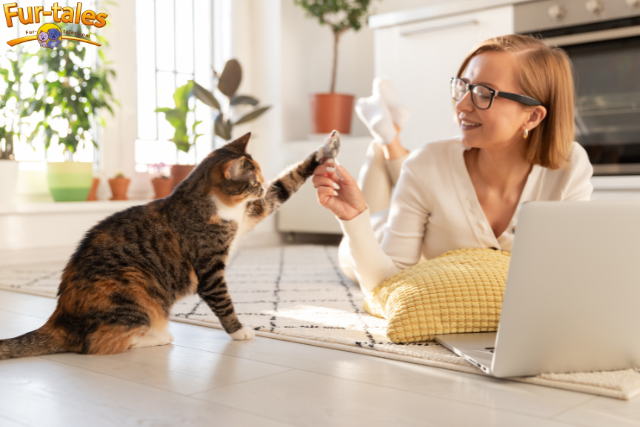
How to Keep Your Cat Entertained Without Buying Expensive Toys
Keeping your cat entertained doesn’t have to drain your wallet. While there are plenty of fancy cat trees, interactive robots, and deluxe towers out there, your feline friend doesn’t need designer toys to stay happy. In fact, many cats are just as enchanted by a cardboard box as they are by a store-bought toy.
In this article, you’ll discover budget-friendly, creative, and engaging ways to stimulate your cat’s mind and body—using items you already have at home or can make yourself.
We’ll cover:
- DIY toy ideas
- Fun games that require zero spending
- Environmental enrichment tips
- How to use food and scent for mental stimulation
- Signs your cat is bored and how to fix it
Why Mental and Physical Stimulation Matters
Just like humans, cats need stimulation to stay healthy and happy. Boredom in cats can lead to:
- Destructive behaviors (scratching furniture, chewing cords)
- Depression or lethargy
- Overeating and weight gain
- Aggression or anxiety
Enriching your cat’s environment improves their well-being, especially if they live indoors. Providing outlets for play, exploration, and hunting behaviors mimics what cats would naturally do in the wild.
DIY Cat Toys From Household Items
1. Cardboard Boxes
Cats love boxes. Big or small, open or enclosed—boxes offer hiding spots, tunnels, and climbing fun. Stack boxes to make a play fort or cut holes for peekaboo games.
2. Paper Bags (Handles Removed)
A crinkly paper bag becomes an instant hideout or pounce target. Always remove the handles first to prevent entanglement.
3. Toilet Paper Rolls
Turn toilet paper rolls into treat dispensers or mini tunnels. Cut slits into the sides and stuff with catnip or kibble.
4. Bottle Cap Chase
Plastic bottle caps skitter across floors, triggering a cat’s chase instinct. Just supervise to ensure your cat doesn’t chew or swallow them.
5. Sock Stuffed With Catnip
Old sock? Meet catnip. Stuff one with dried catnip, tie it off, and let the batting and bunny kicks begin.
6. Wand Toy From a String and Stick
Tie a string to a wooden spoon or chopstick, then attach a feather or scrap of cloth. You’ve just created a wand toy that’s irresistible.
Interactive Games That Cost Nothing
1. Hide and Seek
Hide behind a door or couch and gently peek out at your cat. Many cats love this slow-motion game of stalking and surprise.
2. Laser Pointer Substitute
No laser pointer? Use the reflection of a watch or phone screen in the sunlight to mimic that elusive red dot.
3. Chase the Blanket
Wiggle your fingers under a blanket or towel for a “mystery movement” game. Just watch your hands—those claws are quick!
4. Treat Hunt
Hide small treats around the house or in paper cups. Make your cat use their nose and brain to find each one.
5. Sock Puppet Play
Use a sock as a hand puppet to tease and play, but don’t let them bite your hand—use quick, safe motions and disengage if claws come out.
Scent and Food-Based Enrichment
1. DIY Puzzle Feeders
Take a plastic container with holes and place kibble or treats inside. Your cat will need to roll or paw at it to get food out.
2. Egg Carton Brain Game
Place food or treats in each section of an empty egg carton. This slows down eating and encourages problem-solving.
3. Herbs and Scents
Introduce new scents like catnip, silvervine, or valerian root. Rub it on a towel or sprinkle on a toy to reignite curiosity.
4. Towel Burrito
Wrap a treat or toy in a towel “burrito” for your cat to unravel. This combines play with foraging.
Create an Enriching Environment
1. Window Perches and Views
Cats love to watch the world. Clear a windowsill, install a suction-cup hammock, or set a chair by the window to provide bird and squirrel TV.
2. Vertical Spaces
Stack boxes, use bookshelves, or rearrange furniture to create climbing opportunities. Vertical territory satisfies a cat’s instinct to survey their domain.
3. Sensory Stations
Rotate items like pinecones, leaves, or cardboard tubes that offer new textures and smells. Supervise to ensure safety.
4. Play Rotation
Don’t leave all toys out at once. Rotate them weekly so they stay “new” and exciting.
Enrich Through Routine and Attention
1. Scheduled Playtime
Set aside 10–15 minutes twice a day for focused play. This mimics dawn and dusk hunting behavior.
2. Clicker Training
Yes, you can train a cat! Clicker training with small treats teaches tricks, builds confidence, and strengthens your bond.
3. Talking and Singing
Cats respond to sound and voice tone. Chatting or singing to your cat can be comforting—and entertaining for you both.
Social Enrichment: You’re the Best Toy
1. Interactive Play Sessions
Use feather teasers, string toys, or your own creativity to initiate play. You are your cat’s favorite companion.
2. Grooming Rituals
Many cats enjoy being brushed. This grooming time becomes bonding time and satisfies social instincts.
3. Lap Time and Touch
Even if your cat isn’t a cuddler, simply sitting near you or receiving head scratches can be emotionally enriching.
Signs Your Cat Needs More Stimulation
- Over-grooming or chewing fur
- Aggression toward people or other pets
- Excessive sleeping or lack of interest in play
- Meowing or attention-seeking behavior
- Destroying objects or furniture
If you notice any of these, it’s time to shake up your cat’s routine and reintroduce enrichment strategies.
What to Avoid
- String or yarn unsupervised – These can be swallowed and cause internal harm.
- Plastic bags – Can cause suffocation or choking.
- Toys with small parts – Always check for loose eyes, buttons, or fillers.
- Laser overuse – Without physical reward, laser play can frustrate cats. Always end with a toy they can catch.
